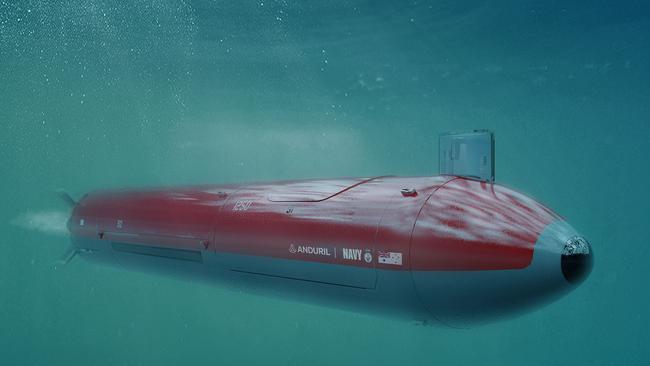Ghost Shark to challenge traditional sea power
Uncrewed sub will create uncertainty in the minds of Australia’s potential adversaries and challenge traditional sea power.

The Ghost Shark uncrewed submarine won’t replace anything in current Navy service because nothing has existed until now that can do its job.
That’s one reason why Defence’s Science and Technology Group and the Royal Australian Navy have invested heavily in it.
Another reason is that it challenges existing capability development and acquisition paradigms: not only is it supposed to enter service very quickly, the contractor who is designing and building it at a secret location on Sydney Harbour, US software giant Anduril, is funding half of the $140m cost of the project as well. Defence’s 50 per cent contribution is funded through the Next Generation Technologies Fund (NGTF) which is administered by DSTG.
The Ghost Shark, or Extra Large Autonomous Underwater Vehicle (XL-AUV), program which began only in July last year, will be controlled by Anduril’s own Artificial Intelligence-powered Lattice Operating System (OS). The concept for Ghost Shark is that it will be an affordable, autonomous, long-endurance and multi-mission system.
“Make no mistake, (XL-AUVs) will be a game-changer,” said former head of Navy Capability Rear Admiral Peter Quinn when he officially named the Ghost Shark last year.
“They will provide militaries with a persistent option for the delivery of underwater effects in high-risk environments, complementing our existing crewed ships and submarines as well as our future uncrewed surface vessels.
“The Ghost Shark program will create uncertainty in the minds of our potential adversaries and will deter both illegal and coercive behaviour,” he added.
“Due to their modular and multi-role nature, our adversaries will need to assume that their every move in the maritime domain is subject to our surveillance, and that every XL-AUV is capable of deploying a wide range of effects, including lethal ones.”
Exact roles and performance targets are classified, but to achieve these goals, it will be modular, customisable and optimised with different payloads for different missions.

And to achieve all of these things quickly, Chief of DSTG’s Platforms Division, Professor Emily Hilder, says “Our view is that the only way we’ll succeed at pace is if we do this together.”
The company aims to have three production-ready prototypes in the water by the end of 2025, though the first of those will be at sea well before then, says Anduril Australia’s chief executive David Goodrich.
DSTG involvement with Ghost Shark began as a conversation with Anduril, followed by a joint proposal from Hilder and Quinn to the Vice-Chief of the Defence Force and then to the minister. The two teams are now intermingled: DSTG and Navy’s Warfighting Innovation Navy (WIN) Branch work with Anduril personnel in Sydney and some Anduril engineers work on DSTG sites.
DSTG brings two important factors to the project, Hilder adds. After more than 40 years of supporting the Navy’s submarine and sonar programs, it has a skilled workforce and deep domain knowledge about the underwater environment, and it understands Navy’s needs.
Some of those experts in computational fluid dynamics, propulsion, energy storage and simulation have transferred seamlessly to the Ghost Shark program. They have been able to take early designs for the Ghost Shark, model them and then test them to determine things like the best shape to balance the conflicting needs of manoeuvrability, propulsion efficiency and stealth. At times, they have turned around one concept design a day.
“If you want to be able to do fast-moving innovative activity well, you need a really strong and broad technology base,” says Hilder. “You can only build a base like that if you have a deliberate, long-term R&D program.”
‘The Ghost Shark program will create uncertainty in the minds of our potential adversaries and will deter both illegal and coercive behaviour’
– Rear Admiral Peter Quinn (retiured), former head of Navy Capability
Anduril’s approach intersects neatly with growing demand from the RAN and DSTG for what the Chief Defence Scientist, Professor Tanya Monro, calls “speed to capability”.
Speed really matters, agrees Quinn: “We need to be able to realise capability more quickly, from concept to getting systems into the hand of our sailors.”
Defence’s forward-leaning leadership means industry can disrupt the old status quo.
Speed is part of Anduril’s competitive advantage in the US and with the active support of Defence it is challenging traditional Australian capability development and acquisition models, Goodrich says.
“Anduril Australia has been working on a different rapid capability development and delivery model,” he says.
“Anduril doesn’t wait for government to fund its ideas and its programs; Anduril uses its own internal sources of capital to develop products ahead of a capability requirement. It takes us anywhere between six and 12 months from idea to fieldable product that we put into the hands of our warfighting customers, and then we rapidly iterate, working with our customers on improving those capabilities.”
The Ghost Shark will be both a commercial and a Defence capability, Goodrich adds.
“We are building for a range of other industries (including) the resources industry, the sub-sea exploration market, particularly the offshore wind market, and they will obviously have very, very different payloads for their particular commercial uses.”
The unprecedentedly close relationship between DSTG, the Navy and the company validates Anduril’s development philosophy of rapid engineering and fielding “evergreen” capability.
“This means that the capability is never finished and we’re continuously upgrading it and updating it, and our adversaries will never know what is coming at them because of this evergreen philosophy and capability that we bring to the table,” Goodrich says.
It also suggests that in an environment of constant innovation and upgrades there is no end state, and this may be Defence’s – and DSTG’s – new reality.


